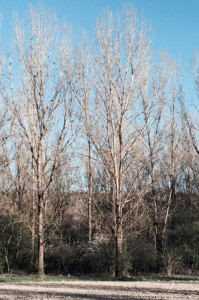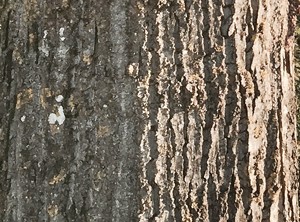Re-populating poplars.

Poplars belong to the same family as the willows. Like willows, they have a 'preference' for wet soil. There are a number of poplar species – white, grey and black poplar and the western balsam poplar, A poplar that is common is the Lombardy Poplar, it is a variant of the Black Poplar and probably the most recognizable poplar, as its branches grow almost parallel to the main stem. It is a tall, thin tree.
The leaves of black poplar (Populus nigra) are arranged along the stems in an alternate fashion. The leaf has a long, slender leaf stalk – which is slightly flattened. The leaf is sometimes described as ‘triangular’ or ‘diamond shaped’. When first formed, the leaves may have a bronze tinge and the young shoots, leaves and stalks have fine, tiny hairs. The upper leaf surface is a dark green, whereas the lower surface is not such a deep green. In Autumn, the leaves may turn a vibrant 'banana' yellow.
 The bark of the Black Poplar is grey / brown and deeply fissured with age. The tree may grow to a height of 100 feet, but is usually smaller than this. The species is dioecious, that is, there are separate male and female trees.
The bark of the Black Poplar is grey / brown and deeply fissured with age. The tree may grow to a height of 100 feet, but is usually smaller than this. The species is dioecious, that is, there are separate male and female trees.
In some parts of the country, like Cheshire, the number of Black Poplars is falling, due to changes in land management, a reduced need for particular timbers and an ageing population of trees.
The natural regeneration of black poplars is limited because :
- male and female trees need to be near each other
- the fertilised seeds are only viable for a short period
- and the seeds need to fall on damp ground
Added to this, there is the risk of hybridisation with other forms of Poplar.
So, The Canal and River Trust in conjunction with Chester Zoo have initiated a program to plant black poplar trees in Cheshire’s Weaver Valley. They have taken cuttings from native Cheshire trees and raised over 1,000 new trees, which have been planted in sites across Cheshire since 1995. For example, male and female trees have been planted by the River Weaver (Hartford) to encourage future natural propagation. Such black poplars can help promote biodiversity, providing homes for moths, bees, birds and butterflies.
Should you have a portion of woodland that has damp soil, and are considering planting some black poplar, there is company that seems to specialise in Poplars : http://www.poplartree.co.uk/poplartree/. It lists some of the uses / benefits of poplars.
Comments are closed for this post.
Discussion
Apparently not uncommon.
https://www.naturespot.org.uk/species/hybrid-black-poplar
There is also the Hybrid Black Poplar which resembles the elm tree (of fond memory). The one I knew was a massive tree that did shed a lot of cotton wool but was next best to the elm.
What has happened to them ?
An interesting subject. Black Poplar is dioecious, with separate male and female trees. They are not a woodland species, but require a more open environment, often near rivers
.
Some year ago I attempted to find both, but was told that females were not being sold because of cross breeding with non native varieties, also that their catkins caused a mess (similar to the closely related American “Cottonwood’).

There were 90 in our village. They grew along the banks of the mill stream. On balance, I think the village would have chosen to poll rather than fell them but the landowner felled the lot with no consultation. Some people hate trees.
Helena
30 July, 2023